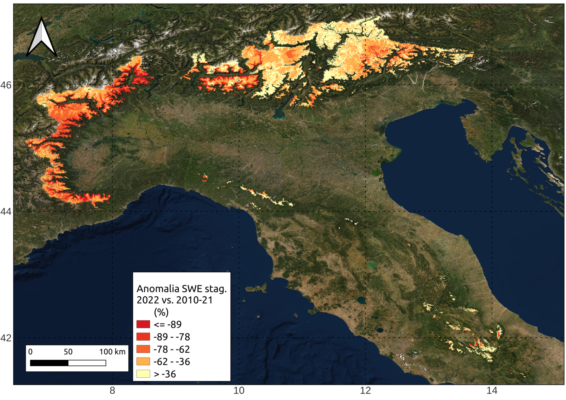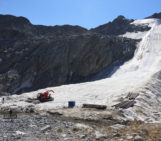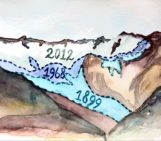
June 2022: I was discussing the ongoing drought with my family over lunch, when my dad pointed to me and summarized things as follows: “You know, less snow in winter means less water in summer!” I almost choked … what? Not only was it the first time I realized my family had been listening to my scientific anecdotes for years, but I also had concrete evidence now that snow was entering public conversations! Sadly, reasons for this are not at all good….
A snow what?
Autumn 2021 started in Italy as we are now used to: very intense storms and floods. On October 4th, for example, my colleagues and I temporarily got stuck at the CIMA Research Foundation offices because all bridges crossing the nearby river were closed due to the ongoing flash-flood peak. Later that month, a Mediterranean cyclone hit Sicily and caused extensive damages and fatalities.
As winter came, rainfalls turned into widespread snowfalls: on December 8th, even coastal towns were covered by snow. Despite the late start due to warm weather, winter snow accumulation across the Italian Alps was on track to be just above average compared to the last 12 years (see figure below). After two winters of lockdown, Italians were enjoying winter at its best!

A comparison between Normalized Snow Water Equivalent in northern Italy for 2021-22 (black line) and the three quartiles of 2010-21 (red line is the median, red band includes the first and third quartiles). Figure credit: S3M Italy by CIMA Research Foundation.
Unfortunately, things didn’t continue as we’d hoped, and the weather became extraordinarily dry and warm as 2022 began. Scientists are still taking stock of how extraordinary 2022 was from this standpoint, but early evidence says that precipitation across Italy was about half of the 1991-2020 average, with a +2°C anomaly in temperature compared to 1981-2010. In severely hit areas like north-western Italy, almost no precipitation fell between December and February.
As a research center developing tools for the Italian Civil Protection, we monitored how these two aspects – a precipitation deficit and warmer temperatures – led to a –60% deficit in water stored as snow across the Italian Alps compared to the most recent 12 years. These estimates tally with satellite estimates showing that the surface area covered by snow in 2022 reached its minimum much earlier than any year over the last two decades.
You call it snow, I call it future water
People often do not realize this, but snow stores water during winter and releases it during spring and summer, when precipitation is not only lower, but also demand from society and natural ecosystems peaks. In other words, snow is like a natural water tower, storing water during winter and releasing it in summer when we need it the most. In some areas of the world, such as the western US, this mechanism provides up to 80% of the annual water supply. By shifting water availability from winter to summer, snow supports life on our planet!
Because snow is so critical, when we first estimated the extent and magnitude of this deficit from our real-time systems, we immediately realized that it would have long-term implications for the summer water supply in Italy. Indeed, rivers across the country did not show the typical increase in water levels due to snow melt between May and July 2022, meaning spring flows were much lower than usual and comparable to those typically seen in late summer. This quickly led to local and national authorities declaring a state of emergency over the summer, triggering various restrictions on water use, especially in the Alpine region.
But the consequences of a snow drought in glaciated regions like the Italian Alps go even deeper: indeed, snow also protects glaciers by reflecting sunlight, and so delaying their melt. This was not the case this year. In a previous Cryoblog post in early July, 2022 was called the “perfect storm” for Alpine glaciers. Two months later, data shows now that glacier mass loss may reach up to the equivalent of two to three average years in just one summer. Warmer temperatures and progressive melt led to dramatic consequences, such as the collapse of the Marmolada glacier in early July 2022. By melting during the summer, glaciers can make up for the lack of rain during droughts. How long is this compensating effect going to last for in a warming climate?

Snow coverage over the beautiful Miage Glacier in the Aosta valley on June 8th, 2022 (left) vs. the average of the 2010-21 period (right). Much of the glacier tongue was already snow-free in late spring. Photo credit: S3M Italy by CIMA Research Foundation, background layer is from the ESRI Satellite Theme.
So, what’s next?
The 2022 Italian drought has all the typical ingredients of the 21st century climate, which we usually summarize with this simple rule: warmer temperatures (and, in this case, lower precipitation) lead to less snow and inevitably less annual water supply.
This rule applies not only to snow-dominated regions (indeed, the Italian snow drought shares key characteristics with the 2012-2016 California snow drought — see here and here). Right now, it is the whole of central Europe that is in severe drought conditions due to low precipitation and warm temperatures (see here and here). Such an extensive water scarcity, combined with a heat wave, has the potential to fuel wildfires, cause excess mortality, and exacerbate historical conflicts around the use of water. As one of the most significant risks of our time, water scarcity rhymes with water security – in Italy and everywhere around the world.
And yet, I think Italians are learning something from this experience. I almost choked a second time when a mountain-hut manager in late July told me that “perhaps you guys don’t realize that, but winter snow is summer water”. Conversations like these became the norm in 2022, to the extent that our awareness of la siccità (drought in Italian) has significantly increased since January. We saw this during our workshops with elementary- and high-school students, who were well aware of the need for saving water. While our prime minister Mario Draghi acknowledged that “there is no doubt that climate change is having an effect”, my colleagues and I were told by farmers in the Liguria region that they started adjusting crop schedules and extent as early as in January, by simply looking at water levels in their small reservoirs.
Snow droughts are projected to increase in the future, but solutions to achieve more sustainable and resilient water management exist! So now is the right time to learn how to mitigate and adapt.

During summer 2022, Italians googled the word ”siccità” (drought) more than during any other period since 2004 Figure credit and data source: Google Trends (https://www.google.com/trends).
Edited by Marie Cavitte
 Francesco Avanzi is a researcher at the CIMA Research Foundation, where he works on the cryosphere-research portfolio. His activities include mountain hydrology and the cryosphere, with a particular interest in developing operational water-forecasting models for cryosphere-dominated regions. He tweets as @WorldOfChecco. Email contact: francesco.avanzi@cimafoundation.org.
Francesco Avanzi is a researcher at the CIMA Research Foundation, where he works on the cryosphere-research portfolio. His activities include mountain hydrology and the cryosphere, with a particular interest in developing operational water-forecasting models for cryosphere-dominated regions. He tweets as @WorldOfChecco. Email contact: francesco.avanzi@cimafoundation.org.

![For Dummies – How do wildfires impact permafrost? [OR.. a story of ice and fire]](https://blogs.egu.eu/divisions/cr/files/2019/10/DJI01011-161x141.jpg)


